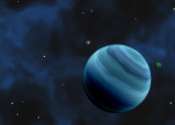Why Pluto is losing its atmosphere: winter is coming
The ominous warning – "winter is coming", popularised by fantasy series Game of Thrones – applies equally well to Pluto.

The ominous warning – "winter is coming", popularised by fantasy series Game of Thrones – applies equally well to Pluto.
Space Exploration
Apr 24, 2019
0
21

Forget the apes, we live on "The Planet of the Beetles". Welcome.
Plants & Animals
Mar 8, 2019
0
4

A NASA telescope that will give humans the largest, deepest, clearest picture of the universe since the Hubble Space Telescope could find as many as 1,400 new planets outside Earth's solar system, new research suggests.
Astronomy
Feb 25, 2019
4
857

Uranus is arguably the most mysterious planet in the solar system – we know very little about it. So far, we have only visited the planet once, with the Voyager 2 spacecraft back in 1986. The most obvious odd thing about ...
Astronomy
Jan 23, 2019
0
104

Using data from NASA's Kepler space telescope, citizen scientists have discovered a planet roughly twice the size of Earth located within its star's habitable zone, the range of orbital distances where liquid water may exist ...
Astronomy
Jan 9, 2019
1
576

The potential discovery of a planet orbiting Barnard's Star – the second closest stellar system to the sun – was announced by researchers today in Nature.
Astronomy
Nov 15, 2018
16
27

The ways in which humans feed, fuel and finance our societies and economies are pushing our planet's natural systems – which support all life on earth—to the edge, according to WWF's Living Planet Report 2018 released ...
Earth Sciences
Oct 30, 2018
1
35

Forty-four planets in solar systems beyond our own have been discovered in one go, dwarfing the usual number of confirmations from extrasolar surveys, which is typically a dozen or less. The findings will improve existing ...
Astronomy
Aug 8, 2018
6
444

NASA's Transiting Exoplanet Survey Satellite has started its search for planets around nearby stars, officially beginning science operations on July 25, 2018. TESS is expected to transmit its first series of science data ...
Astronomy
Jul 27, 2018
0
71

A new instrument to search for potentially habitable/inhabited planets has started operation at the Subaru Telescope. This instrument, IRD (InfraRed Doppler), will look for habitable planets around red dwarf stars. Astronomers ...
Astronomy
Jul 2, 2018
0
18